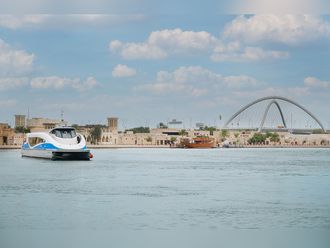The Abu Dhabi Islands Archaeological Survey (ADIAS) yesterday announced the discovery of more Late Stone Age artefacts at the Abu Dhabi Airport Golf Club site, which are believed to be unique in the Arabian Peninsula.
"Further fieldwork carried out at an archaeological site at the Abu Dhabi Airport Golf Club, coupled with a detailed study of flint tools recovered during earlier work at the site have confirmed the importance of the site during the Late Stone Age period, around 5,500 to 4,000 BC," ADIAS said yesterday.
The airport site was first discovered on a range of low hills inside the perimeter of the Golf Club in 1995, when a short season of fieldwork was undertaken by ADIAS.
That work showed that the site had been occupied during the Late Stone Age, the early to middle Bronze Age, around 3,000 BC to 2,000 BC, and in the Late Pre-Islamic period, around the beginning of the Christian era.
During late April, a review of the stone tools and animal remains from the site was undertaken by the ADIAS flint tools expert, Dr Heiko Kallweit, from Germany's University of Freiburg, with the assistance of Dr Mark Beech, ADIAS environmental archaeologist from Britain's University of York.
The review and new finds led to the discovery of microliths (flint sickle-blades), the first known finds in the Arabian Peninsula, and an arrowhead not previously found in the UAE.
This involved a detailed re-examination of material collected during the 1996 field season, as well as two further visits to the site to search for new material that might have been uncovered as a result of the rains early last month.
Dr Kallweit said: "This review and the two site visits have produced valuable new information. "The site was proved to extend further than had been originally recognised, and a nearly complete flint arrowhead was recovered on the southern fringes of the site, as well as a lot of other worked flint material.
"The arrowhead was of a type not previously known to have been found in the UAE, although similar examples have been found in western Saudi Arabia and in Qatar.
"This find provides valuable new information on the possibility of trading routes stretching across the Arabian peninsula during the Late Stone Age period."
During the site visits, Dr Kallweit also found a tiny crescent-shaped fragment of worked flint, known as a microlith, that provides useful insight into the way of life of Late Stone Age inhabitants. Two further examples were also identified during the detailed review of material collected during the earlier phase of fieldwork.
"The three pieces are 'teeth' of flint that would have been set into a wooden handle for use as an early sickle or knife to cut grass," Dr Kallweit said. "Once again, no evidence of such a sickle has previously been recorded in the Emirates, although examples are known from other regions in the near east," he added.
Dr Kallweit further added the discovery confirms that the people were harvesting grass or grains, although it is not possible yet to determine whether they were growing crops, or just harvesting wild plants.
Along with evidence of sheep, goat and cattle bones found on archaeological sites in Dalma, in the far west of the UAE, and at Jebel Buhais, in Sharjah, the sickle pieces confirm that the Late Stone Age inhabitants of this region were not simple hunters and gatherers, but were a pastoral community with a much broader economic base to their lifestyle, Dr Kallweit says.
The newly-identified information has prompted ADIAS to plan for a further season of fieldwork at the airport site next winter. The other fresh discoveries, according to Dr Kallweit, include more flint tools, such as a tiny drill, a piercing tool and a half piece of a scrapper.
James McLean, Manager of the Abu Dhabi Airport Golf Club, welcomes the ADIAS plan. "The Club and its members are proud to have such an valuable archaeological site within its course," he said.
"No other golf club in the country has anything like it, and we will provide ADIAS with any facilities and help that we can in order to help them discover more information about the site. We look forward to working with ADIAS next winter on this important study into the UAE's heritage and history," he added.
The first phase of archaeological investigations at the Abu Dhabi Airport Golf Club in 1996 was undertaken by ADIAS with the support of the Chairman of Abu Dhabi's Civil Aviation Department, Sheikh Hamdan bin Mubarak Al Nahyan, and was supported by Abu Dhabi Duty Free.
Peter Hellyer, ADIAS Executive Director, said: "Our first phase of work proved the importance of this site, and we are grateful for the support provided by Sheikh Hamdan and by Abu Dhabi Duty Free, and for the way in which they have helped to preserve the site."
More Late Stone Age artefacts found
The Abu Dhabi Islands Archaeological Survey (ADIAS) yesterday announced the discovery of more Late Stone Age artefacts at the Abu Dhabi Airport Golf Club site, which are believed to be unique in the Arabian Peninsula.












